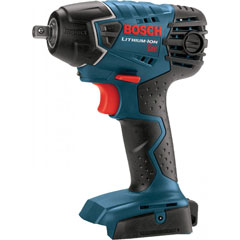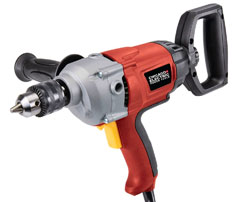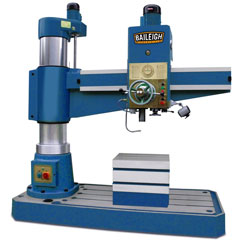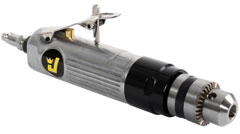30 Different Types of Drills (and Their Uses)

When you think of a drill, you might picture a tool that looks like a gun with a screw-like bit on the end or even an old-fashioned hand tool that resembles an egg beater. But that’s just the tip of the proverbial iceberg.
Here are 30 types of drills and what they do. How many do you recognize?
Related: 41 Types of Drill Bits (and Their Uses)
Common Drills
There’s a good chance you’ve run into some of these drills at some point in your life. They’re all quite useful in your tool box or workshop.
 Benchtop Drill Press
Benchtop Drill Press
Also known as: bench drill, portable drill press
Usually mounted to a workbench, this drill press is a smaller variation of the floor drill press. The drive is positioned vertically above an adjustable platform.
It has numerous uses in workshop activities, thanks to the ability to swap out drill bits for hole saws or other accessories. These can be very powerful and aren’t well-suited for beginners but can be invaluable for veteran craftsmen.
Related: Best Drill Bit Sharpeners to Restore Dull Bits
 Corded Drill
Corded Drill
This powerful drill draws power from an outlet and can provide higher torque than most other drills although cordless drill technologies have caught up or even surpassed their corded counterparts.
Its pistol grip and variable-sized drills make it a comfortable and useful tool. It works equally well in any task involving wood, plastic, metal, or fiberglass. There’s never a worry about running out of battery life although a good extension cord is necessary.
 Cordless Drill
Cordless Drill
Also known as: drill driver
Similar in appearance to its corded sibling, cordless drills employ a battery pack to make them more portable. They’re more easy to transport on a tool belt, but have a limited charge, requiring you to carry spare batteries or recharge between uses.
They can easily handle wood, fiberglass, metal, and plastic, but most aren’t powerful enough to be used on concrete or masonry.
(see our pick for best cordless drill)
 Floor Drill Press
Floor Drill Press
Also known as: pedestal drill, pillar drill
These large workshop drills have the ability to add sanding drums or other accessories to expand their function. Floor standing drill presses are larger than their benchtop siblings but are also more portable in some cases.
A pillar extends from the base to the press, lending to its nicknames. If you have the room for a floor standing model, you’ll get better power, more stability, and a larger work area. Used for cutting holes into or through wood, metal, or other material.
 Hammer Drill
Hammer Drill
Also known as: concrete drill, hammer drill driver
Hammer drills produce a lot of power by using torque from cam plates to slam the drill bit into concrete, stone, or other hard materials. Many models (corded, cordless, even brushless) have the option to switch between hammer, rotary, or combined modes.
While they work best in stoneworking, the ability to switch to rotary mode allows this drill to be used in normal projects.
(see our pick for best hammer drill)
 Impact Drill
Impact Drill
Also known as: impact driver
These stubby drills have a hexagonal socket in place of a normal chuck. Thanks to the percussive action, an impact driver can make quick work of difficult projects.
Automobile work is one of the mainstays for this tool, which does an excellent job at removing various nuts bolts. Its big brother, the impact wrench, is larger and much more powerful.
 Rotary Hammer Drill
Rotary Hammer Drill
Also known as: combination hammer, masonry hammer, rotary hammer
Used mainly in stoneworking trades, the rotary hammer drill is a sleek powered drill with a secondary grip for better handling. While they normally run on electricity, there have been steam-powered models in the past.
Most rotary drivers have an additional hammering function which piledrives the bit as it rotates, leading to much greater drilling power. What sets them apart from regular hammer drills is the use of a piston instead of cam plates to accelerate only the drill bit.
(see our pick for best rotary driver)
Other Drills
In addition to the more common drills are a wide variety of more specialized drills. Some of these drill types you might have seen or even used without ever thinking of them as drills.
 Air Angle Drill
Air Angle Drill
Also known as: right angle drill
With the bit set at 90 degrees to the handle, these pneumatic drills function in the same way as their electric counterparts but without the need for electricity.
The positioning of the bit and small profile also allow you to get into tighter spaces where a full-sized drill might not fit.
 Auger
Auger
Also known as: ground auger, earth auger
While the term auger may be used as a synonym for drill, earth augers are a much larger variant used to bore holes in the ground. There are a wide range of augers out there.
These include one- and two-person models which have a motor mounted above the bit and handles protruding from between them to large bits attached to construction vehicles. The manual versions are used for tapping springs and creating post holes.
 Beam Drill
Beam Drill
As the name suggests, a beam drill is used for making holes in large beams. The most famous brand is Swan which has been used for constructing barns and other similar structures for generations. The drill vertically aligned and the base rests directly upon the wood.
With an open spot in the center for viewing the cutting area. Once the bit is lowered and aligned, you straddle the beam and use the two bicycle pedal-style hand cranks on either side to corkscrew the bit into the wood, then simply reverse the process to remove the bit from the hole.
 Bow Drill
Bow Drill
Also known as: fire drill
Originating from an ancient tool used to start fires, the bow drill has a shaft and movable spindle shaped like a bow. A weight near the base serves as a flywheel. Moving the bow up and down the shaft causes the spindle to turn, creating friction heat.
Although the tool is most often associated with fire making, it has been adapted for use in dentistry and woodworking.
 Brace Drill
Brace Drill
A staple in many woodworking shops, thus U-shaped tool can countersink precise holes. The top spindle is used for positioning and holding the drill, while the middle of the U-shape provides a secondary spindle grip for rotating the drill bit.
The offset of the secondary spindle gives better torque and control when it comes to its intended function.
 Breast Drill
Breast Drill
Also known as: belly drill, chest drill, knee drill
Similar to a hand drill or eggbeater drill, the breast drill is designed to use your body to increase its force. This drill can be found in blacksmith shops and industrial facilities.
A concave plate at the end allows you to lean on the drill to increase its drilling power. In the past, this drill allowed its user to bore holes in steel, iron, and very hard wood.
 CNC Drill
CNC Drill
Also known as: CNC drill press
CNC (Computer Numerical Control) drilling is used in mass production industries to achieve precise holes quickly. The actual drill is often a multifunction tool capable of drilling, boring, milling, and turning.
Due to its pre-programmed functionality, CNC drills are sometimes fully enclosed units with retractable access and an external computer terminal.
Others have a suspended control panel and variable drill tools attached to an angled turret. These latter models rotate to the proper drill tool, then lower the drill onto the object using a ram.
 Core Drill
Core Drill
Also known as: coring drill, annular cutter
When you need to put a large hole into a wall or surface, core drills are the way to go. These cylindrical cutters are often diamond tipped and fit over an auger bit. They leave a solid core or slug in the center.
Coring drills are extremely powerful and require a safety clutch and secondary grip to reduce the risk of injury to the user. They are essentially a large, heavy duty version of a hole saw.
 Cranial Drill
Cranial Drill
This compact surgical tool has an incredibly long history of use, but the more modern versions have proven much safer, thanks to a special clutch that disengages the drill the moment it touches soft tissue.
These drills may be used for relieving cranial pressure or providing access to the brain. Versions are available that use pneumatic, manual, and electric power.
 D-Handle Drill
D-Handle Drill
Also known as: spade handle drill
Named for its D-shaped handle, this drill is used in a wide range of occupations where high torque is needed. There are some variations that use an angled drive for drilling at 90 degrees.
Can be used for drilling and mud mixing and where extra control and a secure grip are needed.
Related: 41 Types of Drill Bits
 Dentist Drill
Dentist Drill
Surpassed only by clowns in the realm of childhood terrors, the dental drill is shaped much like a ratcheting wrench, with a long vertical handle and small cylindrical head. The tiny bit protrudes horizontally.
When in use, the slow models spin at 8,000 RPM, while the fast models have an insane 250,000 RPM. The drill sprays water when in use to prevent overheating and help remove debris from the work site.
 Gimlet Drill
Gimlet Drill
A small form of manual drill, gimlets come in a variety of shapes. They can be used for quickly drilling pilot holes and are incredibly useful in woodworking for starting nail or screw holes.
One variant of the gimlet has a T-shape with a wooden handle and graces many restaurants and kitchens – the corkscrew.
 Hand Drill
Hand Drill
Also known as: eggbeater
Gaining its nickname from its resemblance to an old-fashioned eggbeater, hand drills are not especially powerful and produce rotation via hand crank and gears. Their claim to fame is in their ability to create tiny, precise holes in soft wood or metal that require a delicate touch.
As such, they are treasured tools in woodworking and hobbies such as model building. A more powerful version, the crank drill, is capable of cutting into metal alloys.
 Horizontal Drill Press
Horizontal Drill Press
Also known as: horizontal boring machine
This floor-mounted drill has a forward-facing drill bit. The motor assembly is mounted behind the tool on a heavy spring and a cam handle is used to hold the workpiece down on the table when drilling.
Once turned on, a pedal is used to pull the drill assembly forward into the workpiece. This tool is most commonly found in woodworking shops and can be used to drill accurate holes when preparing wood for furniture or similar projects.
 Mill Drill
Mill Drill
An alternative to milling machines, mill drills are lighter and combine a belt-driven drill press with the same X/Y coordinate functionality of a drill press’s work table. A locking collet helps prevent the cutting tool doesn’t fall off the spindle when exposed to lateral forces.
While milling machines tend to be restricted to industrial use, the smaller mill drill has models appropriate for home use as well as commercial and industrial. As mill drills remove material rather than simply cutting a hole, they are useful in a wide range of construction projects.
 Mini Drill
Mini Drill
Also known as: jewelry drill, precision drill
These tiny drills somewhat resemble precision screwdrivers. While manual versions are best when control is essential, air powered and electric versions are available as well (including rotary tools such as Dremel).
Due to their smaller bit sizes, mini drills are perfect for hobbies such as jewelry-making and model building.
 Paper Drill
Paper Drill
Also known as: paper drill press
This drill is exactly what it sounds like: a sibling of the drill press designed specifically for drilling precise holes in paper.
Depending upon the model, a paper drill can create one or more holes simultaneously in a stack of paper up to two inches thick (i.e. approximately one ream of printer paper).
 Post Drill
Post Drill
Also known as: hand powered drill press
These traditional drills gain their name because they’re best mounted onto posts.
Still used on farms and in some industries, these hand-powered presses can cut through iron but the maximum hole size and depth are limited by the user’s strength and stamina.
 Push Drill
Push Drill
Closely resembling a screwdriver with a threaded shaft, the push drill functions by pushing on the handle.
This turns a nut which, in turn, rotates the shaft. Due to its precision, this tool is useful in woodworking, dentistry, and jewelery-making.
 Radial Drill
Radial Drill
Also known as: radial arm drill, radial drill press
These drill presses have a geared head that can be repositioned along the length of the arm, allowing you to drill holes in a straight line without having to adjust the object or machine’s position.
They have a wide range of uses in metal and woodworking shops, and have the ability to bore through iron.
 Ratchet Drill
Ratchet Drill
This manual drill uses a ratchet-driven chuck on a narrow shaft and handle.
They’re excellent for getting into tight spaces, making them useful in a wide range of crafts, hobbies, and spot repairs.
 Straight Air Drill
Straight Air Drill
These pneumatic drills come in a range of shapes and sizes, from a flashlight-like cylinder to a gun-shape similar to corded drills. The trigger is usually located on the underside, with an air regulator on the top or back.
These drills function just like corded or cordless drills, except they’re safer to use in environments where the drill could come into contact with water, since they don’t rely on electricity to function.
 Two-Headed Drill
Two-Headed Drill
Also known as: SwitchDriver
The two-headed drill is a relatively new concept which combines a cordless drill with an impact driver. The two heads are located on a rotating chuck which keeps the unused head out of the way while engaging the desired head with the motor, although the battery may not hold up to heavy use until the tool has more time to evolve.
These are excellent tools for those who need both tools at once. This tool is best known by the name of the original model, the SwitchDriver by WORX.
See Also: 14 Different Types of Screwdrivers

 Benchtop Drill Press
Benchtop Drill Press Corded Drill
Corded Drill Cordless Drill
Cordless Drill Floor Drill Press
Floor Drill Press Hammer Drill
Hammer Drill Impact Drill
Impact Drill Rotary Hammer Drill
Rotary Hammer Drill Air Angle Drill
Air Angle Drill  Auger
Auger  Beam Drill
Beam Drill Bow Drill
Bow Drill Brace Drill
Brace Drill Breast Drill
Breast Drill CNC Drill
CNC Drill Core Drill
Core Drill Cranial Drill
Cranial Drill D-Handle Drill
D-Handle Drill  Dentist Drill
Dentist Drill Gimlet Drill
Gimlet Drill Hand Drill
Hand Drill Horizontal Drill Press
Horizontal Drill Press Mill Drill
Mill Drill Mini Drill
Mini Drill Paper Drill
Paper Drill  Post Drill
Post Drill Push Drill
Push Drill Radial Drill
Radial Drill Ratchet Drill
Ratchet Drill Straight Air Drill
Straight Air Drill Two-Headed Drill
Two-Headed Drill




